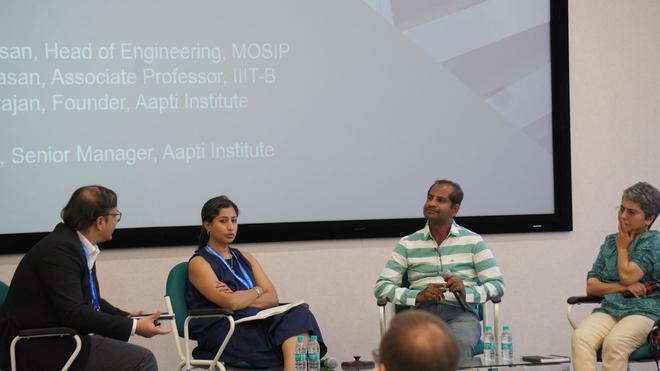About two weeks ago, in a report prepared for G20 prior to the Leaders’ Summit, the World Bank praised the way India harnessed the power of digital public infrastructure such as Aadhaar and UPI to improve financial inclusion and delivery of public goods and services.
The report which was part of G20’s financial inclusion action plan for 2024-2026 shaped under India’s presidency also mentioned other digital ID systems such as Singapore’s Singpass, Philippines’ PhilSys, and UAE’s UAE-Pass.
With more than 1.3 billion registered users, Aadhaar is the largest national biometric digital identification programme in the world. Modular Open-Source Identity Platform (MOSIP), a digital identity platform developed by the International Institute of Information Technology Bangalore (IIITB) has been working on a project to provide digital identities similar to Aadhaar in nine countries including the Philippines, Morocco, Sri Lanka, Uganda, Ethiopia, Republic of Guinea, Sierra Leone, Burkina Faso, and Togolese Republic.
Not entirely foolproof
While India’s digital transformation has achieved huge strides in financial inclusion, the system is not entirely foolproof yet. The twin aims of Aadhaar have been eliminating corruption from the system and inclusion of the underprivileged and weakest sections of society through proof of identity for every citizen.
However, cases of people being excluded from welfare schemes due to failure of authentication or lack of documents like Aadhaar still continue. The onus of fixing it always falls on the citizens, and experts have been pointing out how problematic it is.
“A person’s unique ID is the coming together of their history, the history of a larger administrative system, and various other aspects. That’s why people’s vulnerabilities around IDs are also very unique,” said Dr. Janaki Srinivasan, Associate Professor, IIIT-B. She was part of a panel on ‘Digital divides and inclusion’ at the Trustworthy digital identity international conference by IIITB and The Alan Turing Institute.
“The story we often hear is that when people have multiple IDs it is to make wrong use of the available benefits. But what we found in our research was that in some cases it was simply a way of coping,” said Dr. Janaki, citing the example of women who had to move from their native place after marriage.
She noted that it was similar in the case of several migrant workers too. A migrant who has moved to a big city may need an ID to do transactions in his native and another ID for his transactions in the city. Given the multiple needs and the phase of life in which people are, they may have completely legitimate reasons for having multiple IDs, Dr. Janaki noted.
“Most of the groups we identify as vulnerable have stitched their life together with so many fragile threads. When a new system comes in it’s not so much about the specifics of that system being bad in any sense, it’s just that the system upends what they already know. They are generally not in a position to spend a lot of effort and resources to understand how the new system works. They may find ways around it. But it definitely increases the labour they have to put in to relearn the system, reconfiguring their networks and so on and so forth,” she said.
Grievance has to be humane
BBMP relaunched the ‘Fix My Street’ app earlier this year allowing citizens to report potholes. Within 15 days of launch, the app saw more than 2,500 complaints being registered. The last few years have seen several central and state government departments rolling out similar apps for grievance redressal.
While apps for grievance redressal may sound excellent in theory, they get more complicated in real according to experts. Citing a field study done in three states, Sarayu noted that grievance redressal in India has mostly been mediated.

According to Sasikumar Ganesan, Head of Engineering at MOSIP, digital systems have the inherent problem of not being humans. He remembered how his father, whenever faced with a problem regarding his property transactions, would walk up to one of the department staff, tell them his situation, convince them, and get them involved to find a solution.
“The moment it moved online, things changed. Now his only option was to depend on me to fill things out online. Grievance has to be humane, and it is going to be a tough exercise,” he said.
Dr. Srinivasan echoed similar sentiments and noted that the state was legally bound to take upon the onus of people being excluded and carry out grievance redressal.
“Fixing where that accountability is and how you take that accountability forward is a very critical priority. It may get better with time. But we cannot totally expect to learn it on the field,” she said.
Inclusion vs security
In June, COVID-19 vaccination data of several Indians was reportedly leaked on a Telegram bot. The data leaked from the government-funded CoWIN portal included name, gender, birth details, Aadhaar numbers, PAN cards, passport numbers, voter IDs and vaccination centre details as per reports.
Data breaches make citizens extremely vulnerable to scams, manipulation, and exploitation. Reports suggest that Aadhaar related scams have been on the rise in the country.
“There’s a huge difference between building an inclusive technology and a technology that prevents fraud and ensures security privacy. Sometimes they are on opposite sides,” said Mr. Ganesan, adding that inclusivity has to be the basic principle on which the system works.
He also pointed out how using biometrics for verification can be inclusive and exclusive.
“My father can’t remember passwords and asks the security person’s help to type in the PIN and withdraw money from the ATM. But when it comes to fingerprint authentication, he is perfectly okay. But I have also seen people standing in queue unable to get their fingerprints authenticated. It’s not their fault, yet they are being denied service,” he said.
In June, the Odisha High Court, while hearing a writ petition on the plight of malnourished children from villages in the Jajpur district, had ruled that failure of Aadhaar card, mobile phone, or identity papers of a particular kind were no grounds to exclude people from welfare schemes
“It is important to keep improving your security layers keeping the north star as inclusion and not the other way around. The day you start doing it the other way around and try to prevent more people from fraud, you are going to exclude more people from this system,” Mr. Ganesan said.
Host of factors
Panelists also pointed out that within the idea of the universality of IDs, the question of whether it was framed as a policy or a right deserved significant consideration, and the question of inclusion had to be framed accordingly.
In the case of women particularly many factors mediated the securing and usage of an ID, said Sarayu Natarajan, founder of Aapti institute.
“How women get out, the cost of taking time off to get an ID - a whole range of such factors determine whether a woman can get out or not in the first place... Thinking through what this identification means conceptually and in what ways you would be viewed by the state and to some extent private entities are also significant questions that mediate the identity,” she said.
She also noted that while inclusion into the system was often perceived as a one-time thing, in reality it is a constantly negotiated process. “Technological shifts and social practices can end up including and excluding people. It is a complex journey,” she said.







